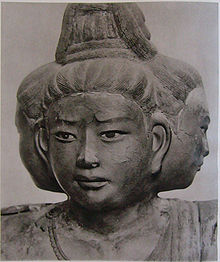Asura (Buddhism)
Asuras are "heavenly" beings. The term Asuras is also sometimes translated as " titans ", "demigods" or "warring gods". In Buddhism , the asuras belong to the top three of the six realms (between humans and devas ). The characteristic emotion of the Asuras is jealousy. They are often depicted as warlike beings who skirmish with the devas and always lose. Sometimes the modern world is referred to as the asura realm because people are constantly in a hurry to pursue material goals which they mostly cannot achieve after all.
Thailand

In Theravada Buddhism in Thailand , the Asuras are seen similarly. A detailed account of the realm of the Asura was first described in the traditional worldview of the Thai Buddhists of the Traibhumikatha from the 14th century. The “world of sensuality” ( Kamaphum - กาม ภูมิ ), one of three worlds, is - unlike in Mahayana Buddhism - divided into a total of eleven regions, of which the four “Sorrowful Regions” ( อบายภูมิ - pronunciation : [ ʔàbai pʰuːm ], or also ทุคติ ภูมิ - [ tʰúː kʰá-tʰì pʰuːm ], literally places or times of punishment ). The sorrowful regions are the “region of the hell beings” ( นรก ภูมิ ), the “region of the animals” ( เดรัจฉาน ภูมิ ), the “region of the preta ”, the hungry spirits ( เปรต ภูมิ - see: hunger spirit ) and the “region of the Asura demons ”( อสุรกาย ).
- There are two types of Asura: some are dark and deformed, their body is 1/4 yojana . The others are called the Exalted Asura . The dark, deformed Asura have bodies so thin that not the slightest flesh and blood can be found on them. Their eyes are as small as those of a crab and are upside down, their mouths are as small as the eye of a needle. They are incapable of experiencing the slightest feeling of happiness in their life, they are the most miserable of all asura. The region of the Asura is 10,000 yojana wide, it is located below Mount Meru . The human region is 84,000 yojana above the Asuras. There are four major cities in which the asura live, each ruled by a king. In the middle of the asura land there has been a khae-foi tree ( dolichandrone crispa ) that is 80 yojana high since the beginning of the earth .
The best-known representative of the Asura in Thailand is the demon Rahu , a figure in Hindu mythology. He drank the elixir of immortality Amarit ( Amrita ) , was then beheaded by the god Vishnu , and must now eat the sun and moon for all eternity (solar and lunar eclipses). But since it has no body, the stars reappear after a while. Rahu is often depicted in a very stylized way on the gables of religious buildings; here he is mostly reminiscent of a lion's head made of foliage and tendrils.
Further representations of Asura can be found on the stone reliefs in many Khmer temples.
See also
swell
- Frank E. Reynolds (transl.): Three Worlds According To King Ruang . Berkeley, 1982. ISBN 0-89581-153-7
Web links
- Thailand:
- The Myth of Rahu and the Lunar Eclipse ( January 25, 2010 memento in the Internet Archive ) Announcement of a performance of Joe Louis' puppet theater (in English)

